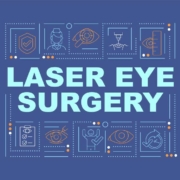Refractive Lens Exchange Surgery: Everything You Need to Know
By Dr. Anthony Nappi / May 12, 2022 / 5 min. read

Did you know that more than 60% of people in the United States wear corrective lenses? That’s right, perfect vision is a far-off dream for many Americans.
If you wear glasses or contact lenses, you know how frustrating it can be. All it takes to set you back is to break or lose a lens. Wouldn’t it be nice if you had great vision without the need for glasses or contacts?
Refractive lens exchange surgery might be able to help. We’re here to talk about this increasingly-popular eye surgery so you can determine if it’s right for you. Read on to learn more.
What Is Refractive Lens Exchange?
Refractive lens exchange surgery is a lesser-known type of vision-correcting eye surgery. It’s suitable for many people who aren’t good candidates for the more well-known type of eye surgery: LASIK.
During the procedure, the surgeon removes the lens of the eye and replaces it with an IOL (intraocular lens). In other words, an implant. It’s very similar to cataract surgery, which is the most performed operation in the US and the World.
One of the biggest benefits of refractive lens exchange surgery is that it’s a good option for people who are “too old” to reap the benefits of LASIK. It’s also good for people who are in the early stages of developing cataracts as it will prevent future cataract growth. The implants cannot form cataracts.
Who Is Refractive Lens Exchange Surgery For?
Many people who aren’t candidates for LASIK are still good candidates for RLE eye surgery (and people who are good LASIK candidates are also good RLE eye surgery candidates). Keep in mind that it’s advisable for patients to be over the age of forty before they get RLE, but if you’re not, talk to the surgeon about your options. Some people can get RLE as long as they’re over the age of 21.
Nearsighted patients, farsighted patients, patients with astigmatism, and patients with age-related vision changes (presbyopia) can all benefit from reflective lens exchange surgery, even if they have underlying eye conditions or abnormally-shaped cornea (which may exclude them from LASIK).
If you have thin corneas that prevent you from getting LASIK, refractive lens exchange surgery is a fantastic option for you.
There are several different types of artificial lenses that surgeons can implant into the patient’s eyes. Each lens will suit a different type of eye problem.
- Monofocal intraocular lenses are for people who are looking to correct a single problem (like nearsightedness).
- Multifocal lenses are good for people who need adjustments to see at various distances (often people who wear bifocal glasses).
- Accommodating lenses are more advanced and they can correct vision from all distances.
- Light Adjustable Lens™ stands as the only adjustable intraocular lens (IOL) available, providing the opportunity for vision optimization following lens implantation and recovery.
As with any other procedure, it’s important to have a long talk with a qualified doctor to determine whether or not you’re a good candidate for reflective lens exchange surgery.
What to Expect Before and During the Procedure
During your initial appointment, your eye doctor will give you an evaluation. They want to make sure that you’re in good physical health and that your eyes are healthy enough for the procedure.
They’ll order some tests to check your vision and look for underlying eye health conditions before you commit to the procedure.
Before the appointment, your doctor will give you instructions on how to prepare for your refractive lens exchange surgery. Make sure to ask questions if anything is unclear.
You may be asked to use special antibiotic eye drops. You may have to stop taking certain medications if they can get in the way of your healing. You may also have to stop wearing contact lenses for a brief period before surgery.
On the day of your surgery, make sure that you have someone available who can drive you home. You won’t be able to drive yourself.
Your surgeon will use a topical anesthetic to make the procedure more comfortable. Once you’re numb, the procedure should only take about fifteen minutes. The surgeon simply makes an incision, removes your natural lens, and replaces it with the artificial intraocular lens.
In most cases, the surgeon will only work on a single eye, so you’ll have to come back for a second appointment for the second eye surgery. In some cases, the surgeon may do both eyes at the same time.
Aftercare and Healing
RLE eye surgery is fairly straightforward and the healing process tends to be easy for most patients. If you experience anything unusual, never be afraid to reach out to your doctor.
Again, you won’t be able to drive yourself home. It’s a good idea to have someone with you at home at least for the first few hours after your surgery to make sure that you have what you need.
If you know that you’re going to be home alone, have everything that you need within arm’s reach of a comfortable place to rest.
You may experience some redness, swelling, and discomfort at first. Likely, your vision will still be slightly blurry and you may experience light haloes. With that in mind, vision correction should be obvious right away even though your eyes won’t be “perfect” yet.
Most people are able to get back to their day-to-day activities within about a week, but you’ll need to follow your doctor’s instructions. At Barnet Dulaney Perkins, we do DROPLESS surgery, so there are no medicinal eye drops after surgery.
Is Refractive Lens Exchange Surgery Right for You?
Refractive lens exchange surgery is a quick and effective vision-correcting eye surgery that’s a great option for people who aren’t candidates for LASIK. If you struggle with vision problems and you want a life-changing procedure, it might be the best choice for you.
At Barnet Dulaney Perkins Eye Center, we do more than just LASIK. We want to make sure that all of our patients can get the crystal-clear vision that they deserve.





 iStock Photography
iStock Photography iStock
iStock